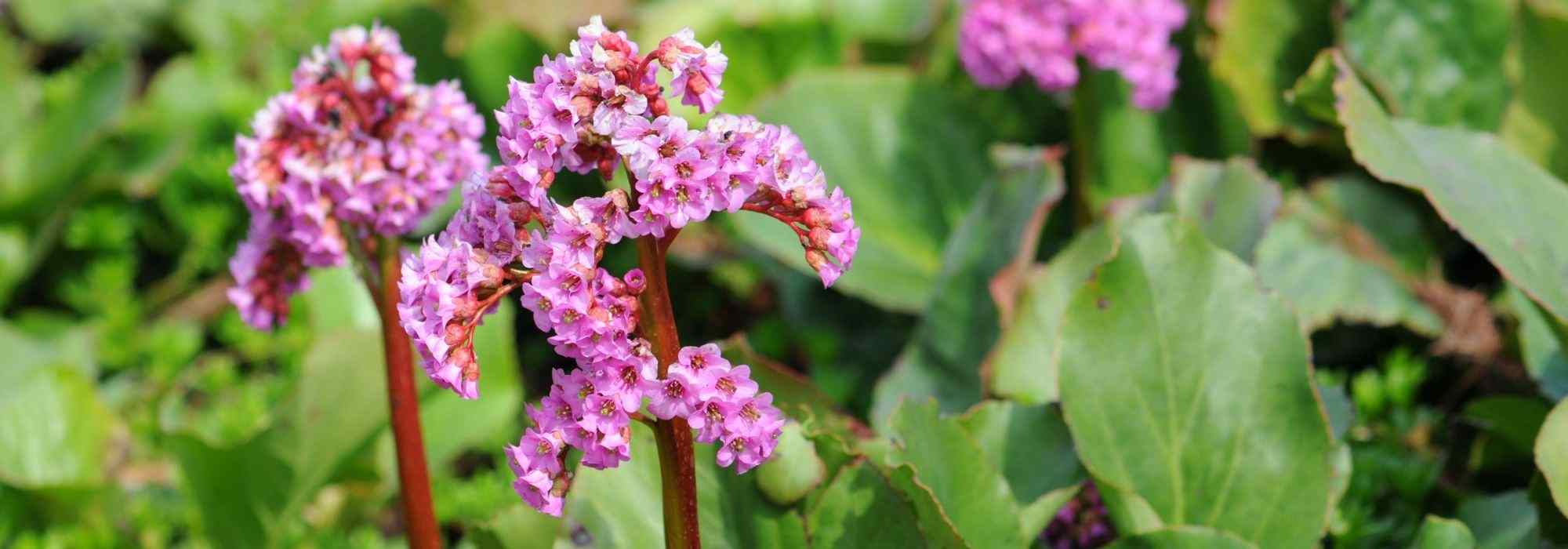
5 groundcovers for clay soil
for borders, slopes, or beds
Contents
Creating a flower bed in clay soil requires careful selection of plants. Indeed, clay soil is synonymous with moisture and water retention. Not all plants can thrive in it, as the soil is heavy, suffocating for the roots, and its composition makes it muddy and sticky when it rains. However, unlike sandy soils, the soil stays cool for longer in summer, which allows for less frequent watering, provided that a severe drought does not create a crust on the surface that prevents water from penetrating. Discover our selection of flowering groundcovers with colourful evergreen, deciduous, or semi-evergreen foliage to grow in clay soil!
Mukdenia rossii ‘Crimson Fans’: a remarkable changing foliage
The Mukdenia rossii ‘Crimson Fans’, native to Northern China and Korea, features voluminous foliage that changes colour throughout the seasons! In spring, this deciduous perennial showcases young bronze shoots and green palmate leaves measuring 13 cm in diameter, transitioning to dark green with a purple edge in summer, and finally turning completely purple in autumn. This Manchurian Ivy forms a compact clump 35 cm high and 50 cm wide, and blooms from April to May before the foliage appears: star-shaped white flowers emerge in panicles on thick stems. This Mukdenia is also known by the variety name ‘Karasuba’. In spring or autumn, plant it in partial shade in clay, humus-bearing, cool soil and mulch its base for summer, as it enjoys moisture. Before winter, cut its foliage back to the ground when it turns yellow and mark its location to avoid trampling the future buds that will grow in that spot.
A very hardy plant, grow Mukdenia rossii ‘Crimson Fans’ at the front of a shrub border or in a mixed border with Hostas, Japanese Anemones, Bleeding Hearts, Hakonechloa macra ‘Naomi’, Polystichum polyblepharum, Gunneras, and Astilboides tabularis.
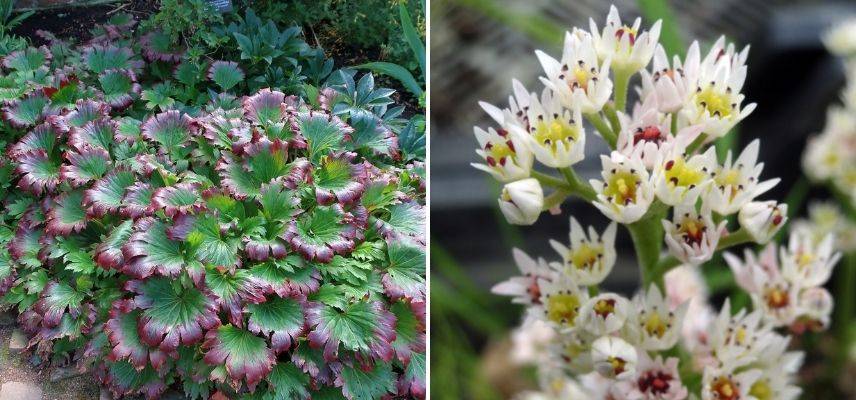
Mukdenia rossii ‘Crimson Fans’ (photo by cultivar413 – Flickr)
Pulmonaria saccharata ‘Silverado’: a silver marvel
Evergreen throughout the year except during severe frosts, this cousin of Borage and Brunneras brightens and enlivens shaded areas. Indeed, its clump consists of villous lanceolate light green leaves speckled with silver and pendulous pink bell-shaped flowers turning to violet-blue. The Pulmonaria saccharata ‘Silverado’ produces its floral stems 30 cm high from March to May and provides pollen to beneficial insects in early spring. Thus, its early flowering is important for pollinators. Particularly heat and disease resistant, expose the Spotted Lungwort to partial shade or shade, knowing that the foliage will be more beautiful in a semi-shaded position. Planting can be done in March or autumn in humus-bearing, cool, and heavy soil. Hardy beyond -15°C, however, it is sensitive to heat. Therefore, it is important to water it during dry spells to keep its roots cool.
The ‘Silverado’ Lungwort fits perfectly in woodlands, as groundcover in a border or on slopes, and at the edge of flower beds associated with spring bulbs such as Camassias and Daffodils, with Brunneras macrophylla ‘Starry Eyes’, Geranium nodosum, Comfrey, and small Astilbes.
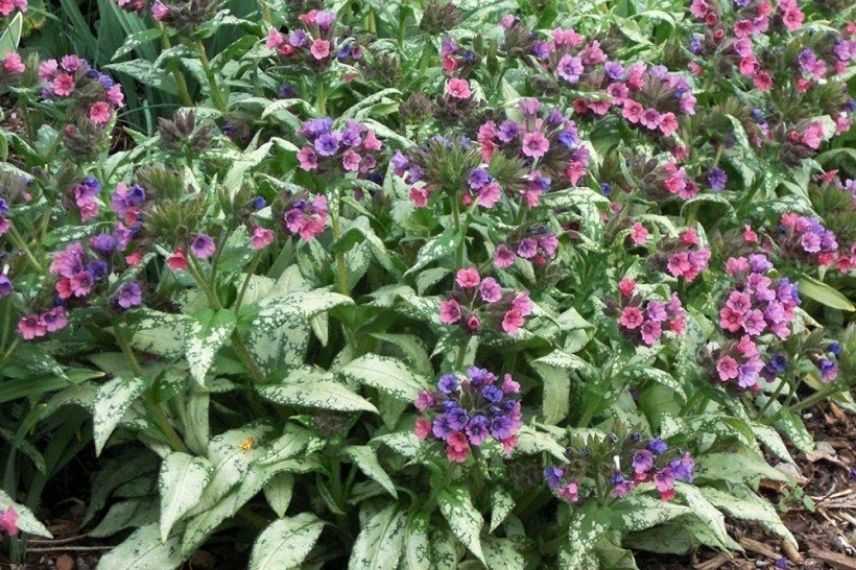
Pulmonaria saccharata ‘Silverado’
⇒ Other varieties of Lungworts to discover on our site.
⇒ Planting, growing, and caring for Lungworts, we tell you everything!
Discover other Ground cover perennials
View all →Available in 0 sizes
Available in 1 sizes
Available in 0 sizes
Available in 0 sizes
Available in 0 sizes
Available in 0 sizes
Available in 1 sizes
Available in 0 sizes
Available in 0 sizes
Available in 0 sizes
Persicaria affinis ‘Kabouter’: a profusion of floral spikes
Very vigorous and hardy, this perennial is an excellent, highly floriferous ground cover from July to September, sometimes even until October. This Persicaria, or Himalayan Knotweed, grows to 30 cm tall and forms a dense, glossy green carpet that turns purple in autumn. The main attraction of Persicaria affinis ‘Kabouter’ is its flowering, composed of 8 cm spikes with changing colours! Indeed, a beautiful gradient of colour appears on flowers transitioning from pink to purple-red. Persicaria establishes quickly in cool, clayey soil and is easy to maintain; simply cut back the dry flowers when they are no longer decorative. However, be cautious, as it can become invasive.
In March or October, plant it in a sunny or partially shaded location along paths, in borders, in large pots, or on slopes, paired with Bergenias, Hostas, grasses such as Molinia caerulea ‘Moorhexe’, Asters, Solomon’s Seal Polygonatum odoratum, and Astrantias.
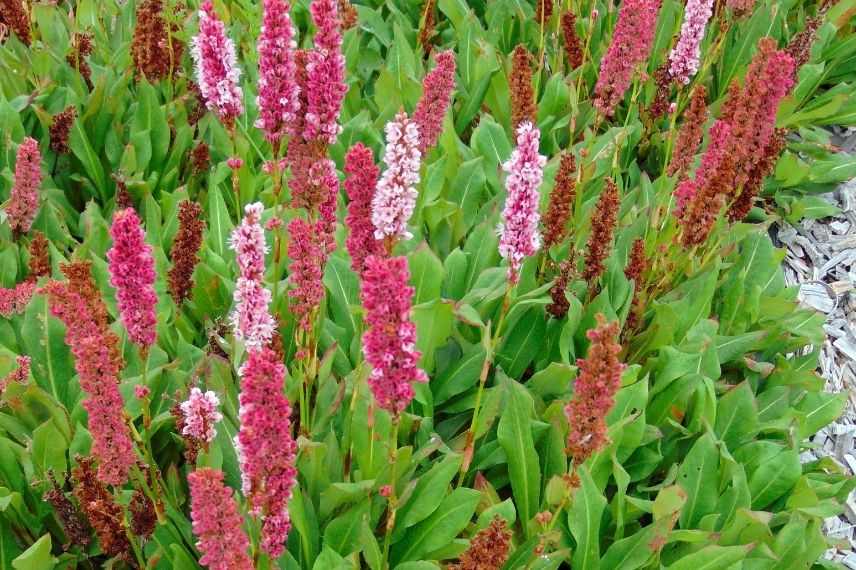
Persicaria affinis ‘Kabouter’
⇒ Discover other varieties of Persicarias in our range.
⇒ Learn all about planting, cultivation, and maintenance of Persicarias!
Houttuynia cordata ‘Chameleon’: a brightly variegated foliage!
Houttuynia cordata ‘Chameleon’, native to Asia, spreads as a multicoloured groundcover in cream, pink, and green, hence its name ‘Chameleon’. This is where its aesthetic appeal lies. Also known as Wood Coriander or Chinese Pepper, its deciduous heart-shaped foliage is aromatic and emits a lemony, peppery scent, making it a condiment used in Asian cuisine. Its intermittent white flowering occurs from June to July and continues until November. With good hardiness, Chinese Pepper prefers rich, cool, and heavy soils, particularly clay. In spring, plant it in a semi-shaded position so that the few rays of sunlight it receives maintain the beautiful colours of its foliage. Regarding maintenance, it should be watered during periods of intense heat and drought to prevent water stress. Additionally, the rhizomes of this perennial develop underground, and Houttuynia can become invasive, especially along riverbanks or ponds. Use this perennial preferably in large spaces, as it has a rapid growth rate, allowing you more time to manage it.
Loving moisture, use it in woodland areas, by the edges of banks and ponds, or to fill wet grounds alongside Epimedium warleyense, Greater Periwinkle, Pachysandra terminalis, Cotoneaster suecicus ‘Coral Beauty’, and Lonicera nitida ‘Red Tips’.
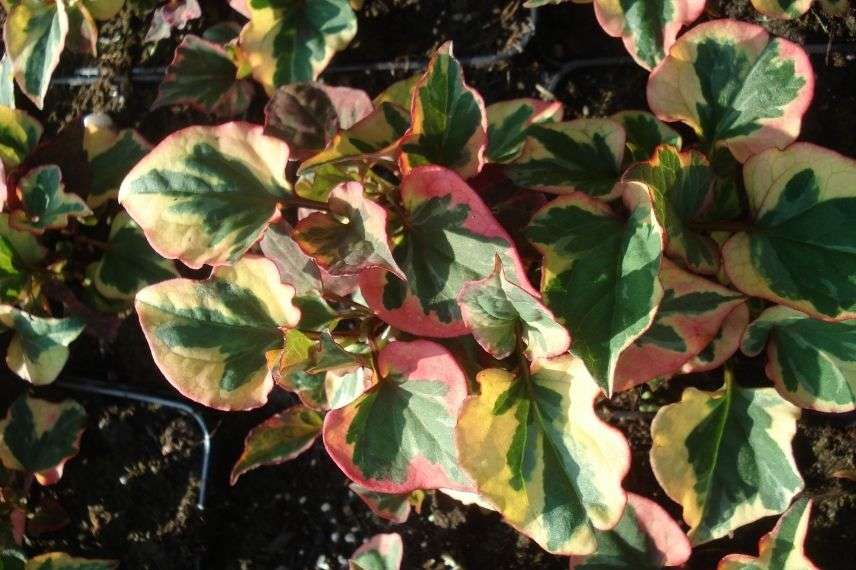
Houttuynia cordata ‘Chameleon’
Omphalodes verna: an adorable spring flowering
This groundcover, also known as Bluebell or Venus’s Navel, forms a semi-evergreen tuft about twenty centimetres high that spreads through its stolons to reach 30-40 cm in spread.
The rounded, slightly crinkled light green leaves are accompanied from March to May by bright blue flowering. The small flowers of Omphalodes verna closely resemble those of the Forget-me-not with their white centre. Plant this perennial in early autumn or spring, in partial shade, in rich, cool humus soil. Avoid complete shade as it harms its flowering; it would be a shame not to fully enjoy its charming blue flowers. It tolerates clay, heavy, and calcareous soils very well. This hardy groundcover can withstand temperatures below -15°C, is low-maintenance, and requires little care. Moreover, it is resistant to diseases, with only slugs and snails being its enemies.
Position this woodland plant at the edge, at the front of a flower bed, on a slope, in a cool rockery, or under trees and bushes to create a flowering carpet with Wood Anemone, Hepatica, Wood Hyacinths, Sweet Violets, Ajuga reptans, Stachys grandiflora ‘Superba’, and Phuopsis.
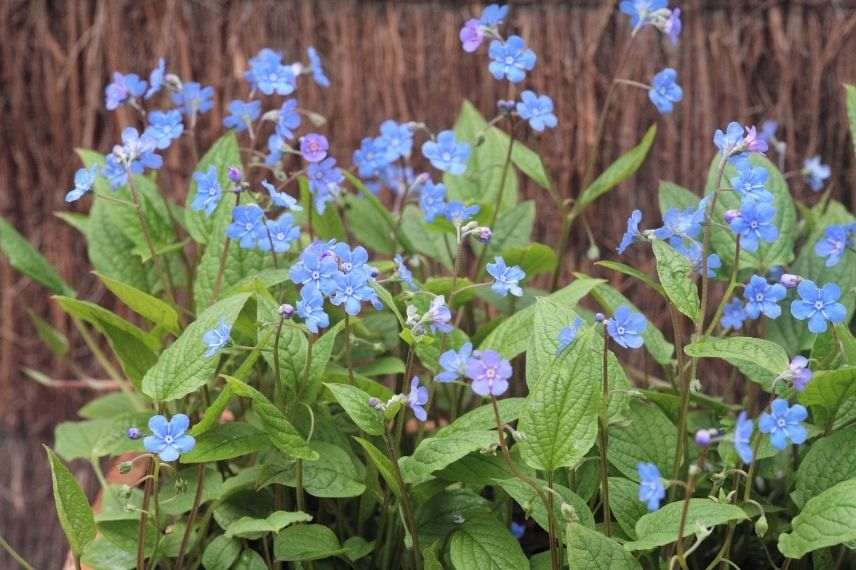
Omphalodes verna
⇒ Different varieties of Omphalodes are available online on our site.
⇒ Planting, growing, and caring for Omphalodes: all the advice in our dedicated guide.
- Subscribe!
- Contents
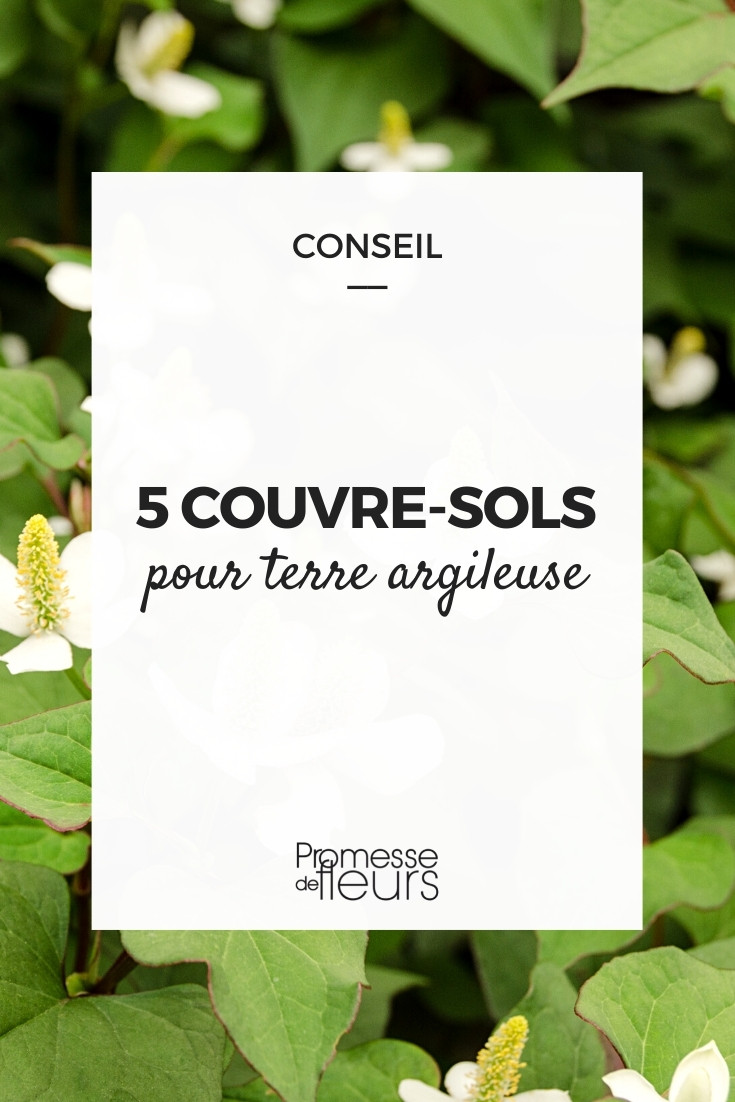































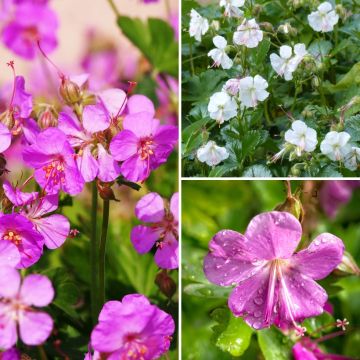
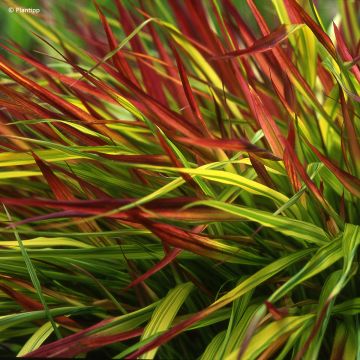
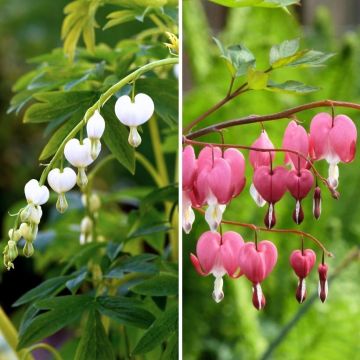
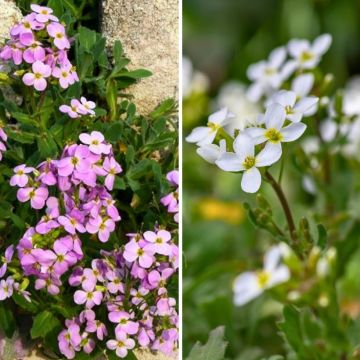
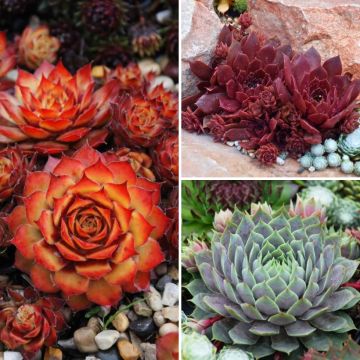
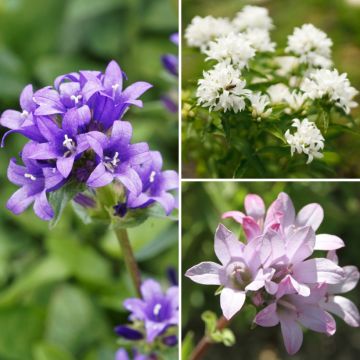
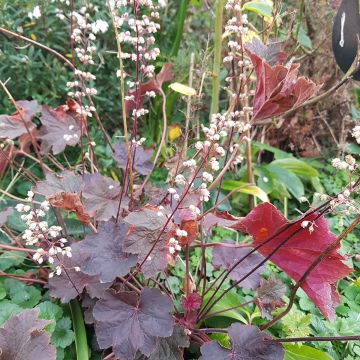
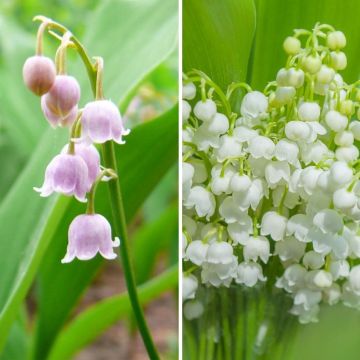
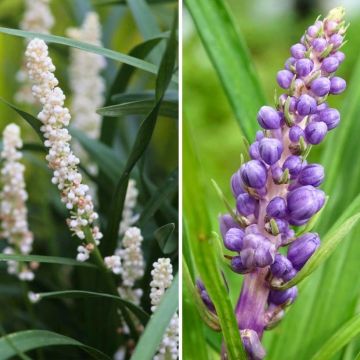
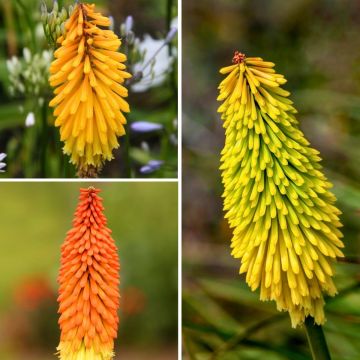
Comments